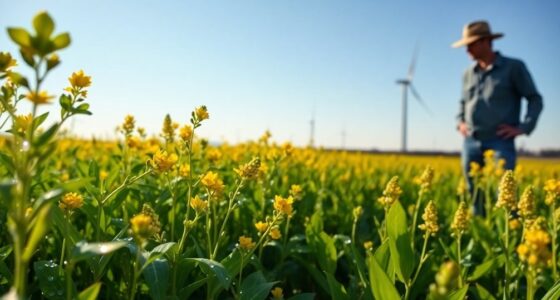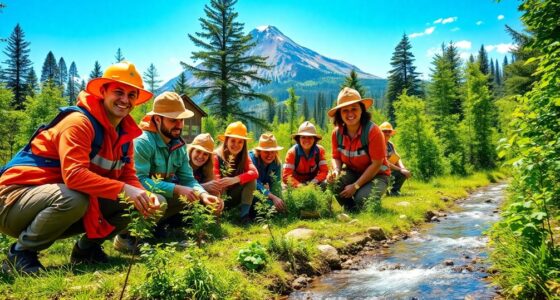The Amazon's fighting back against deforestation by leveraging technology, empowering indigenous communities, and implementing effective conservation strategies. Advanced satellite monitoring systems track forest changes in real-time, helping to identify illegal activities. Indigenous groups manage significant portions of the land, which reduces deforestation rates. They play an essential role in shaping sustainable practices and protecting their territories. Innovative methods like agroforestry provide local communities with alternative income while fostering environmental health. By combining these efforts, the Amazon is creating a resilient framework against deforestation. If you want to learn more about these initiatives and their impact, just keep exploring.
Key Takeaways
- Advanced monitoring technologies, like satellite systems, provide real-time data to track deforestation and illegal activities in the Amazon.
- Indigenous communities, managing over 30% of the rainforest, play a crucial role in reducing deforestation rates through sustainable practices.
- Strong legislative measures, including the Forest Code, enforce land use regulations and promote compliance among landowners to protect forest cover.
- Conservation corridors and concessions support local economies while safeguarding biodiversity, enhancing ecological resilience against deforestation.
- Community engagement initiatives foster awareness and empower local populations, promoting sustainable land management practices to combat deforestation effectively.
Overview of Deforestation in the Amazon

Deforestation in the Amazon poses a grave threat to our planet's ecological balance, as it has already led to the loss of 20% of this essential biome.
This destruction, largely driven by cattle ranching, accounts for around 80% of forest loss, impacting the Amazon's crucial role as a carbon sink. As you might know, it now absorbs much less carbon dioxide than it did two decades ago, contributing to 15% of global CO2 emissions.
The consequences extend beyond the environment, affecting over 350 indigenous communities who face loss of food sources and exposure to foreign diseases.
While there are protected areas aimed at sustainable development, the ongoing climate change crisis demands urgent action to combat the alarming trends of deforestation in the Amazon.
Key Contributing Factors
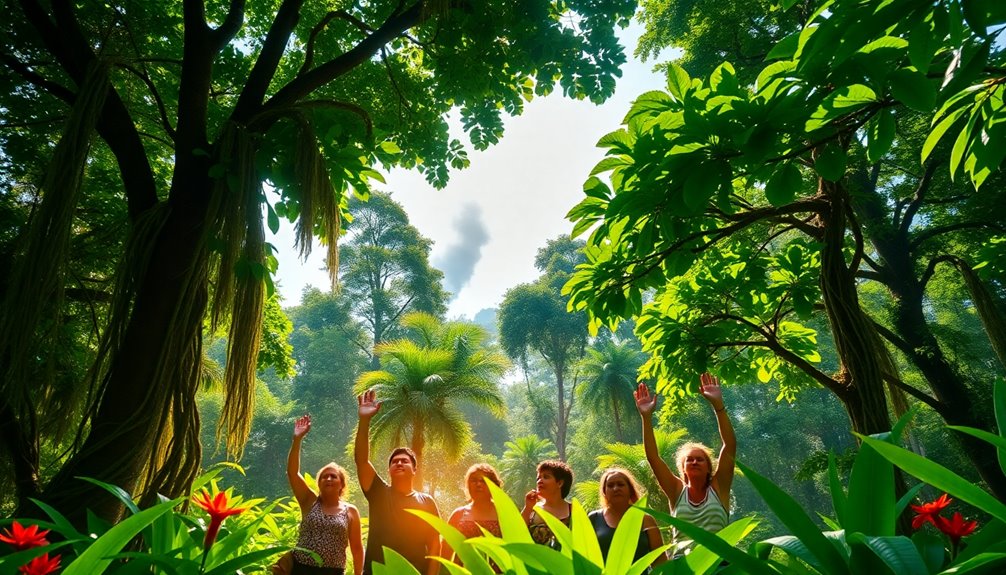
While various factors contribute to the alarming rates of forest loss in the Amazon, cattle ranching stands out as the leading cause, driving approximately 80% of deforestation.
Brazil's vast cattle population, around 200 million, meets global beef demand, pushing the destruction of primary forests.
Infrastructure development also plays a significant role, with 95% of forest loss occurring near roads or rivers. Major projects, like the Trans-Amazonian Highway and hydropower dams, further exacerbate deforestation, displacing ecosystems.
Additionally, small-scale subsistence agriculture using slash-and-burn techniques contributes to about 27% of global forest loss.
The impact of fire, primarily caused by human activities, transforms once lush rainforest into more fire-prone landscapes, threatening the livelihoods of indigenous peoples and the delicate balance of the Amazon rainforest.
Environmental and Social Impact
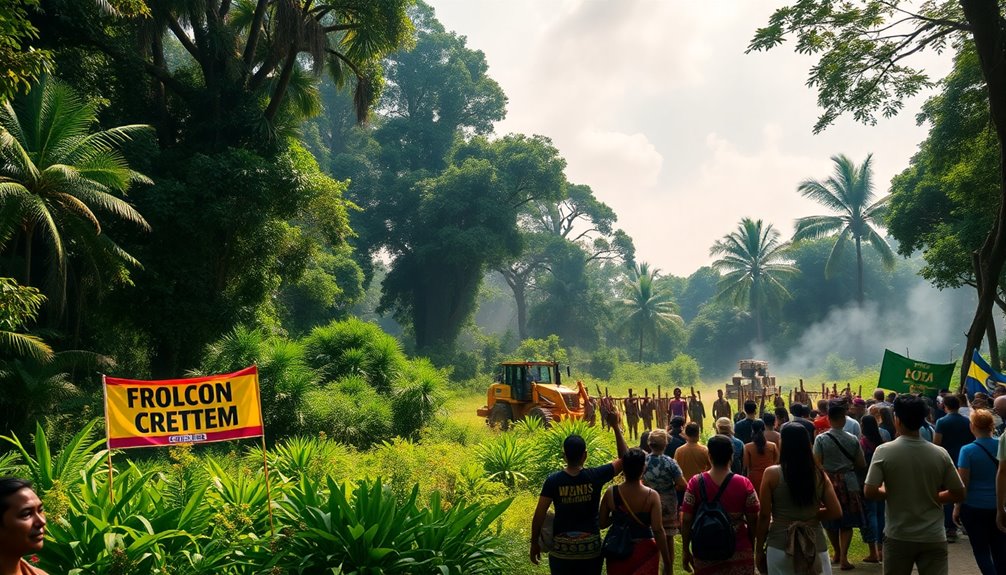
As the Amazon rainforest continues to shrink, the environmental and social impacts become increasingly dire, affecting not just the ecosystem but also the lives of countless people.
Deforestation threatens over 350 indigenous communities, stripping them of food sources and traditional livelihoods. This not only disrupts biodiversity but also undermines social and economic development.
As the Amazon's capacity for carbon sequestration diminishes—dropping nearly half in two decades—global CO2 emissions rise, exacerbating climate change.
The disruption of the water cycle leads to droughts that jeopardize agriculture worldwide, further impacting food security.
Ongoing human-caused fires transform lush forests into savannah-like biomes, heightening vulnerability to future fires and loss of biodiversity, making forest conservation an urgent priority.
Monitoring and Technology
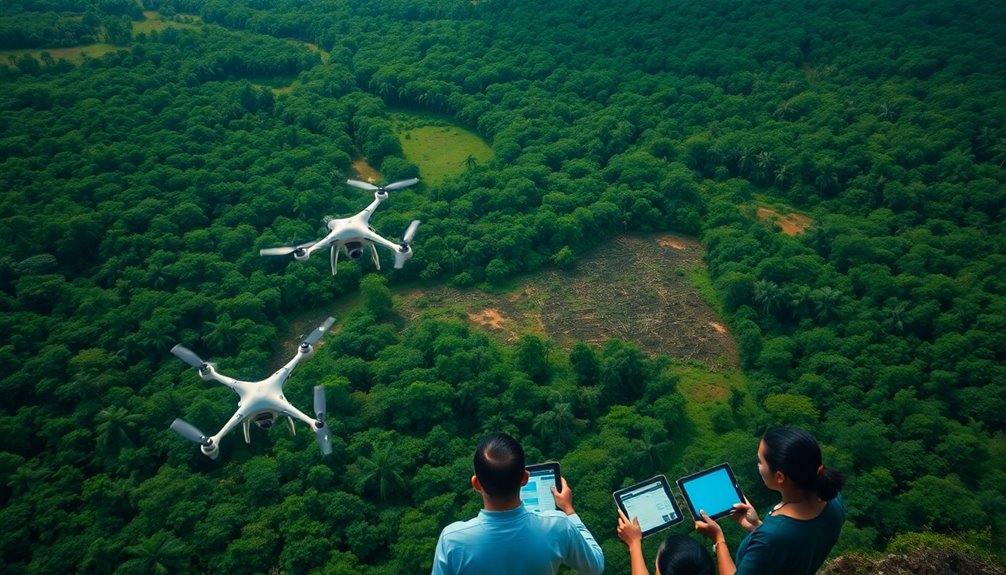
To effectively combat deforestation in the Amazon, advanced monitoring technologies play a crucial role in tracking changes in the landscape.
Satellite systems like Brazil's DETER and Global Forest Watch provide near-real-time data, enabling swift responses to illegal activities.
The MAAP Project enhances community engagement by alerting locals about deforestation threats, fostering conservation efforts.
With around 99% of recent fires linked to human activity, these monitoring systems help pinpoint outbreaks often tied to deforestation.
The Instituto Nacional de Pesquisas Espaciais (INPE) conducts annual satellite assessments, supplying essential data for policy and enforcement.
Moreover, innovations like drones and radar improve monitoring accuracy, making it easier to combat illegal land use practices and protect the Amazon's crucial resources.
Indigenous Rights and Involvement
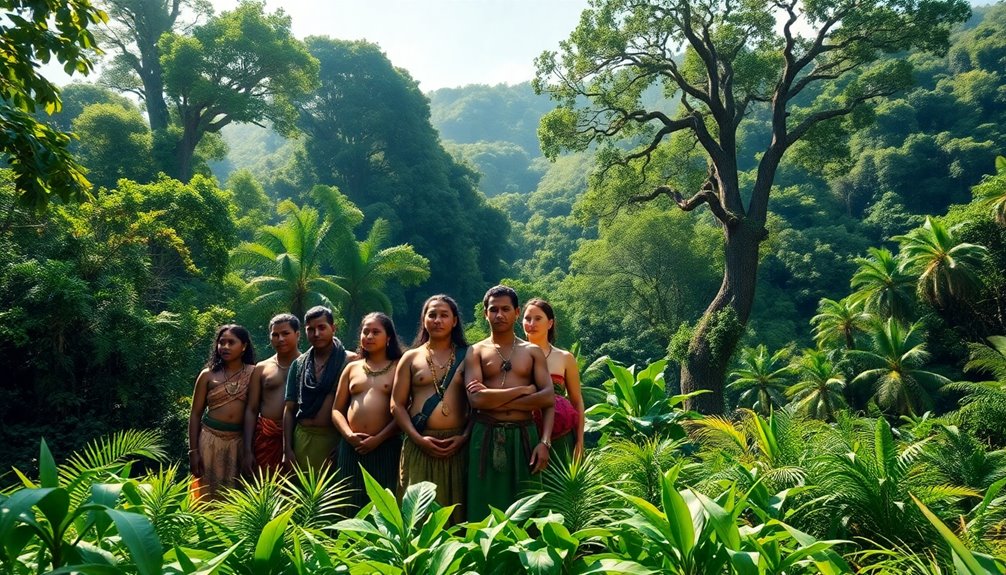
Indigenous communities play an essential role in protecting the Amazon, managing over 30% of its rainforest.
To support their efforts, it's important to empower these groups through legal protections and collaborative conservation initiatives.
Empowering Indigenous Communities
Recognizing the vital role that local communities play in rainforest conservation is key to addressing deforestation in the Amazon. Indigenous communities manage over 30% of the rainforest, and their territories experience deforestation rates that are half those of surrounding lands. This illustrates their effectiveness in safeguarding ecosystems through traditional knowledge and sustainable practices.
However, less than 1% of international climate assistance reaches these communities, revealing a significant gap in funding support for Indigenous-led conservation efforts. By empowering Indigenous leaders, like Tuntiak Katan and Juan Carlos Jintiach, who advocate for environmental justice, we can guarantee their voices shape significant decisions.
Supporting land rights and recognizing their role in conservation is vital for the future of the Amazon and its biodiversity.
Legal Protections and Challenges
While the Amazon rainforest teems with life, the legal protections for the over 350 indigenous communities living within it often fall short.
These communities play a significant role in forest management, exhibiting deforestation rates half of those in surrounding areas. Their traditional knowledge is essential for effective conservation efforts, yet less than 1% of international climate assistance reaches them.
This gap highlights the need for stronger legal protections and support for indigenous-led initiatives. Activists like Tuntiak Katan emphasize the importance of directly involving indigenous voices in decision-making processes.
Collaborative Conservation Efforts
Collaborative conservation efforts thrive when local communities are empowered to protect their environments. Indigenous communities manage over 30% of the Amazon rainforest, achieving deforestation rates half that of surrounding areas. Leaders like Juan Carlos Jintiach advocate for Indigenous rights and environmental protection, showcasing the significant role these communities play. However, less than 1% of international climate assistance reaches them, underscoring the need for increased funding. Recognizing land rights is essential, as it combats threats from illegal activities and enhances biodiversity conservation. By involving Indigenous peoples in decision-making, we can promote sustainable land management practices that benefit both the forest and its guardians.
| Key Aspects | Impact on Conservation |
|---|---|
| Empowering Indigenous communities | Reduces deforestation rates |
| Land rights recognition | Enhances environmental protection |
| Increased funding | Supports sustainable initiatives |
| Community-led management | Boosts biodiversity conservation |
| Advocacy and leadership | Strengthens collective conservation efforts |
Legislative Measures and Policies
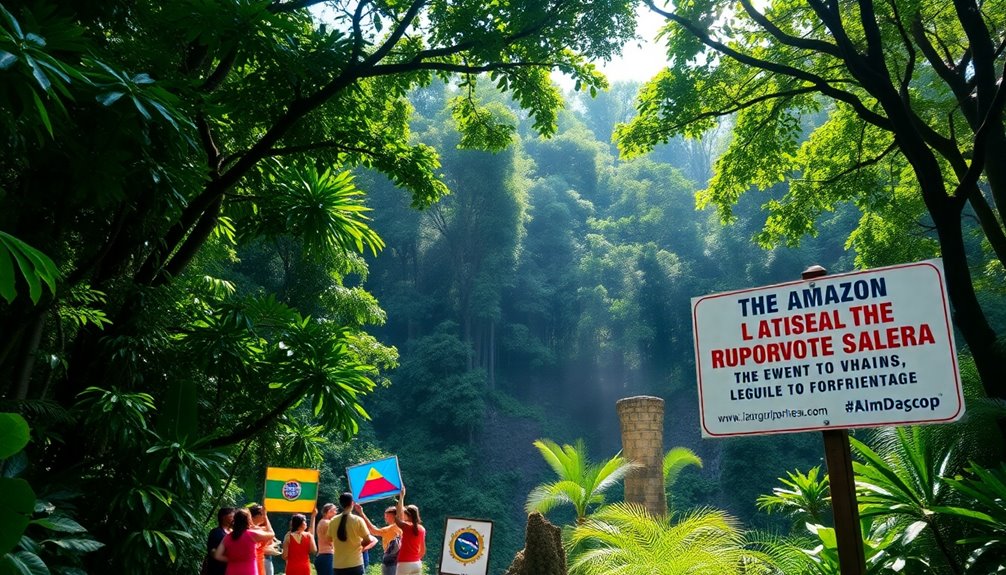
To effectively combat deforestation in the Amazon, you need to recognize the importance of reinstating strong policies and regulations.
Enforcement of these measures is essential, and collaborative governance will play a key role in ensuring that all stakeholders are engaged.
Policy Reinstatement Importance
As Brazil's experience from 2004 to 2012 demonstrates, reinstating strong legislative measures can greatly curb deforestation rates in the Amazon.
- Effective enforcement of the Forest Code is vital.
- Coordinated efforts between federal and state governments enhance land use planning.
- Continuous evaluation strengthens the fight against illegal mining.
Reinstating policies that prioritize forest protection is essential for reducing deforestation levels.
The Brazilian government must focus on proper land tenure data to combat the alarming rates of forest loss.
With 21% of deforestation linked to unregistered areas from 2012-2021, it's clear that effective policy reinstatement can make a difference.
Enforcement of Regulations
While Brazil made significant strides in reducing deforestation through strong legislative measures from 2004 to 2012, the enforcement of these regulations remains critical to sustaining those gains. The Forest Code plays a key role in guaranteeing compliance among landowners by mandating a percentage of forest cover. Effective coordination between federal and state governments is essential for proper environmental licensing and inspections.
| Key Aspects | Importance |
|---|---|
| Enforcement | Guarantees adherence to laws |
| Monitoring Systems | Detects illegal practices |
| Compliance | Maintains forest cover |
| Forest Code | Regulates land use |
| Environmental Licensing | Promotes responsible use |
Utilizing monitoring systems like satellite imagery and Brazil's DETER enhances transparency and combats illegal deforestation effectively.
Collaborative Governance Approaches
Collaborative governance approaches play an important role in the fight against deforestation in the Amazon, particularly through well-crafted legislative measures and policies.
- Brazil's Forest Code serves as an essential regulatory framework for managing land use.
- Coordination between federal and state governments is necessary for effective enforcement.
- Continuous evaluation of land tenure structures combats illegal land occupation.
Conservation Strategies and Models
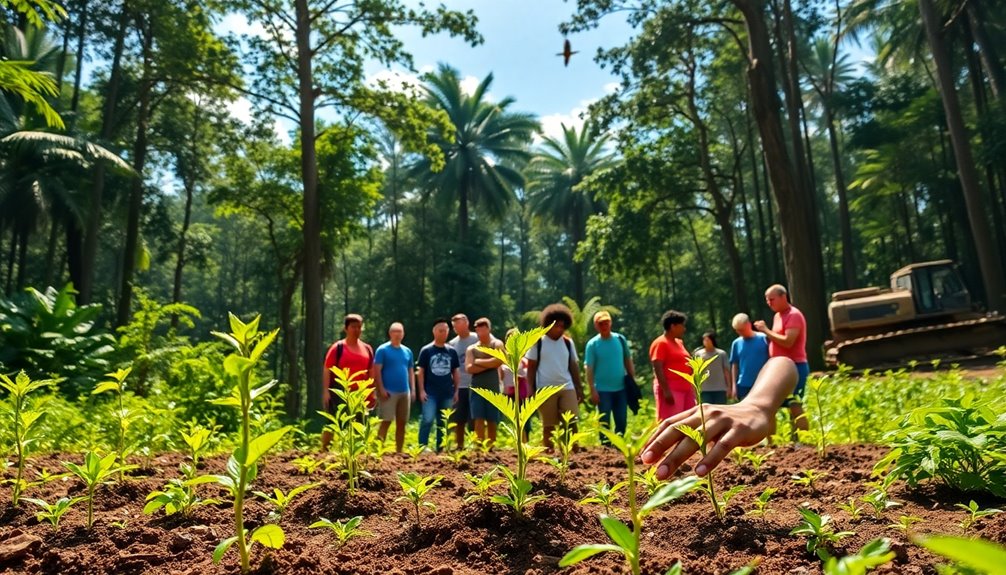
To effectively combat deforestation in the Amazon, various conservation strategies and models have emerged, showcasing innovative approaches that blend environmental protection with community needs.
Conservation concessions, like the Los Amigos Conservation Concession, exemplify successful public/private partnerships, protecting vast rainforest areas while benefiting local economies.
Additionally, indigenous stewardship is critical, as seen with the Haramba Queros Wachiperi Conservation Concession, safeguarding biodiversity and cultural heritage.
Conservation corridors, such as the Manu-Tambopata Corridor, enhance biodiversity conservation by connecting fragmented habitats.
Establishing protected lands in Peru and Bolivia emphasizes sustainable forest management practices.
Finally, technological innovations, including satellite imagery and radar monitoring, play an essential role in tracking deforestation and supporting these initiatives, ensuring effective responses to illegal land use.
Future Challenges and Solutions
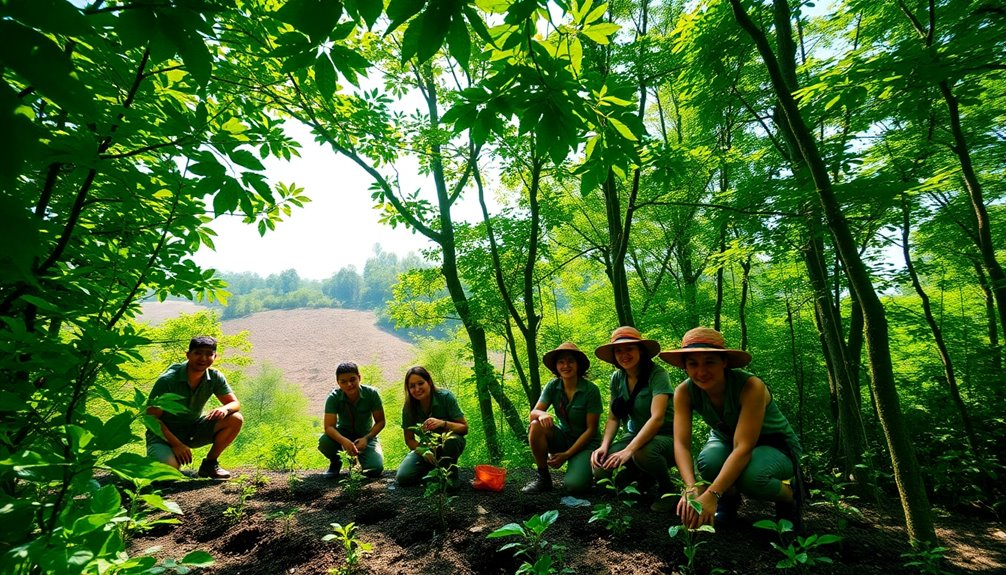
As deforestation in the Amazon escalates, the challenges ahead require urgent attention and innovative solutions.
You'll need to evaluate multiple approaches to preserve this essential ecosystem:
- Empower local communities through sustainable land management practices.
- Secure indigenous territories to leverage their effective stewardship.
- Implement advanced monitoring technologies for real-time deforestation tracking.
To combat deforestation, integrating economic policies that encourage restoring degraded lands will be imperative.
By supporting agroforestry and alternative income sources for local communities, you can reduce reliance on harmful agricultural practices.
Additionally, ensuring land rights for indigenous populations has proven effective, as they maintain lower deforestation rates.
Together, these strategies can create a resilient framework for the Amazon's future, balancing ecological health with economic viability.
Frequently Asked Questions
What Is Being Done to Stop Amazon Deforestation?
To stop Amazon deforestation, various initiatives are underway.
You can support monitoring technologies that track illegal activities in real-time. Legislative measures have proven effective in reducing deforestation rates, so advocating for strong policies is crucial.
Engaging with indigenous communities helps protect these lands considerably. Additionally, participating in international initiatives like the LEAF Coalition can mobilize resources for conservation.
Together, these efforts create a powerful approach to preserving the Amazon's forests.
What Are the Four Methods Being Used to Protect the Amazon Rainforest From Deforestation?
Protecting the Amazon rainforest from deforestation is like weaving a tapestry of efforts.
You've got monitoring technologies that track deforestation in real-time, collaborating with indigenous communities to uphold their stewardship practices, enforcing strong legislative measures under Brazil's Forest Code, and establishing conservation corridors to link habitats.
Each method plays a crucial role, helping you safeguard this essential ecosystem while promoting biodiversity and sustainable development for future generations.
What Is Brazil Doing to Stop Deforestation of the Amazon?
Brazil's taken several steps to stop deforestation in the Amazon.
They've implemented the Forest Code, which mandates landowners maintain forest cover.
You'll see satellite monitoring systems tracking deforestation in real-time to catch illegal activities.
Recent laws focus on regularizing land tenure, targeting illegal occupations that drive deforestation.
Plus, Brazil's committed to reducing emissions from deforestation as part of its Nationally Determined Contribution under the Paris Agreement, showcasing its dedication to climate action.
What Are They Doing to Stop Deforestation?
Did you know that Indigenous territories in the Amazon have deforestation rates half that of surrounding lands?
To stop deforestation, you're seeing advanced monitoring technologies like satellite imagery being used for real-time tracking.
Legislative measures, including Brazil's Forest Code, are regulating land use effectively.
Additionally, conservation concessions and initiatives like the LEAF Coalition are mobilizing funds and promoting sustainable development, ensuring that local communities can implement effective conservation practices.
Conclusion
In the battle against deforestation, the Amazon's vibrant heart isn't just weathering the storm; it's adapting and thriving. By embracing innovative technologies and empowering local communities, you're witnessing a remarkable resilience unfold. While challenges still loom, with a little hope and collective action, the Amazon can transform into a lush sanctuary once more. So, let's nurture this green gem together, ensuring it continues to flourish for generations to come. After all, every leaf counts in this vital fight.



